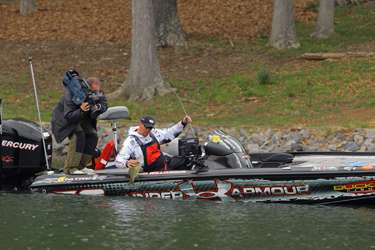
You made the perfect walk-the-dog retrieve around that stickup, but your presentation failed to trigger a strike. What went wrong? "A lot of people like to watch their bait and see how pretty they can walk it, but that's not always the most natural presentation," says Elite Series pro Jason Williamson.
"I'm not saying you can't catch a fish doing that in the fall, because you can, but to catch more numbers and get more bites, I firmly believe in throwing chrome topwater baits really, really fast."
The South Carolina pro usually relies on a jig when the money is on the line in a tournament, but one of his favorite ways to catch bass in the fall is with a topwater plug.
"In the fall, all around the country, most of the bass are schooling and herding bait, and a lot of times they're surfacing," he says. "When they're not surfacing, they stay suspended. It's a big challenge to catch suspended bass, but I think one of the best ways to catch suspended bass in the fall is on a topwater plug."
Whether the lake he's fishing contains herring or shad, Williamson tries to match the color and size of the forage. Since he notices bass tend to chase smaller baitfish in the fall, Williamson opts for midsize topwaters such as the original Zara Spook, Super Spook Junior, Sammy 100 and Sammy 85.
When the surface is slick, Williamson chooses a Sammy for his topwater presentation, but he switches to the Spook whenever there's a ripple or chop on the water. "A lot of times in the fall you'll get on a couple of lakes where the baitfish are real, real tiny," says Williamson. "A lot of people ask me how to catch those 3- and 4-pounders that are surfacing and schooling on shad that are less than an inch long.
The way to get around matching the hatch in a lot of those areas is working a topwater bait really fast and using really reflective colors." The two-time BASS winner favors chrome hues or other reflective colors for his topwater plugs custom painted by Buckeye Lures.
He believes the combination of reflective colors and the fast retrieve prevents the fish from detecting the actual size of the bait. "So they react on it for what it is right then and there," he says. "That's a big key to catching bass in the fall behind other people." Unlike other seasons, when bass are using cover to ambush prey, fall is a time when bass are chasing bait in open water and have to react quickly to fleeing forage.
"When they see that chrome reflection skipping across the water, it's a natural reaction for them to come and get it," says Williamson, who favors employing this presentation in slightly stained to ultra-clear water. He suggests the clearer the water, the faster the retrieve.
The need for speed in his presentation prompts Williamson to either retrieve his topwater with a fast walk or reel it quickly to make the Spook or Sammy skip across the surface.
He burns his lures on top with a 6-foot, 9-inch medium-heavy Duckett Fishing Micro Magic rod and a Bass Pro Shops Johnny Morris Gold Series baitcasting reel (7.1:1 gear ratio) with 15-pound McCoy Mean Green monofilament line. In most fall situations, Williamson finds bass suspended over shallow humps and long points. After graphing the structure to find balls of baitfish, Williamson usually positions his boat over depths of 25 to 30 feet and throws his topwater lures towards the structure where the fish will be suspended 8 to 10 feet deep.
Since bass have a tendency to shake loose of topwater plugs as you're fighting them to the boat, Williamson recommends replacing the hooks when you buy a new topwater lure to increase your chances of landing fish. "Don't ever leave the original factory hook on it," he warns. "Get some EWG-style hooks and stay about the same size or one size bigger.
Be careful though not to oversize your hook too much. It could make the bait sink in the water more and affect the lure's action."





